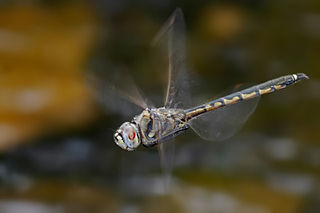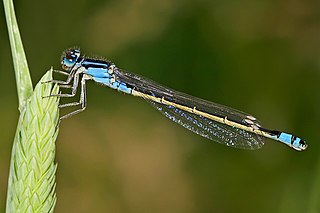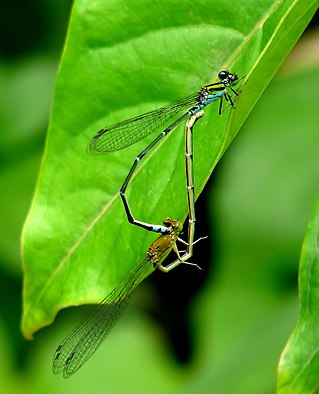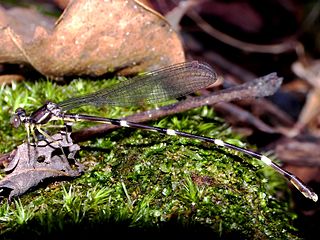
Cephalaeschna is a genus of dragonflies in the family Aeshnidae.

Ceriagrion is a genus of damselfly in the family Coenagrionidae. Species of Ceriagrion are small to medium size, generally brightly coloured damselflies. They are found across the Old World, Africa, Asia and Australia.

Gynacantha is a genus of dragonflies in the family Aeshnidae. The females have two prominent spines under the last abdominal segment. This gives the genus name and the common name two-spined darners; they are also known as duskhawkers.

Hemicordulia is a genus of dragonfly in family Corduliidae. It occurs in Africa, southern Asia, Australasia and Pacific Islands such as the Bonin Islands, Fiji and French Polynesia. Species of Hemicordulia are small to medium-sized dragonflies, coloured black or metallic, with yellow.

Indolestes is a genus of damselflies in the family Lestidae. Species of Indolestes can be medium-sized, dull coloured dragonflies. They are found from India through Asia, Australia and the Pacific.

Ischnura is a genus of damselflies known as forktails in the family Coenagrionidae. Forktails are distributed worldwide, including various oceanic islands. The males have a forked projection at the tip of the abdomen which gives the group their common name.
Leptogomphus is a genus of dragonfly in the family Gomphidae. It contains the following species:

Mortonagrion is a genus of damselfly in the family Coenagrionidae. It contains the following species:
Oligoaeschna is a genus of dragonfly in the family Aeshnidae. It contains the following species:

Platycnemis is a genus of damselfly in the family Platycnemididae.

Prodasineura, the Asian threadtails, is a genus of damselflies in the family Platycnemididae. All the Afrotropical species formerly in this genus are now placed in Elattoneura, the African threadtails. Dijkstra et al. (2014) moved the genus from Protoneuridae to Platycnemididae based on molecular phylogenetic research.

Pseudagrion is the largest genus of damselfly in the family Coenagrionidae, with over 140 species. Its range includes most of Africa, much of Asia, and Australia. Africa holds most of the diversity with almost 100 species. It has occupied most of the freshwater habitats in its range, and dominates damselfly communities in habitats as different as desert pools, equatorial rainforests and montane streams.

Rhinocypha is a genus of damselflies in the family Chlorocyphidae.

Vestalis is a genus of damselflies belonging to the family Calopterygidae.

Coeliccia is a genus of damselflies in the family Platycnemididae. They are distributed in Asia from India to Japan to Indonesia. It is the largest genus in the family, with around 80 species.
Megalestes is a genus of malachite in the damselfly family Synlestidae. There are at least 20 described species in Megalestes.

Protosticta is a genus of shadowdamsel in the damselfly family Platystictidae. There are more than 50 described species in Protosticta.
Indocypha is a genus of jewel damselfly in the family Chlorocyphidae. There are about eight described species in Indocypha. The species was first spotted in Thailand.

Heliocypha is a genus of jewel damselflies in the family Chlorocyphidae. There are about nine described species in Heliocypha, found in Indomalaya.















